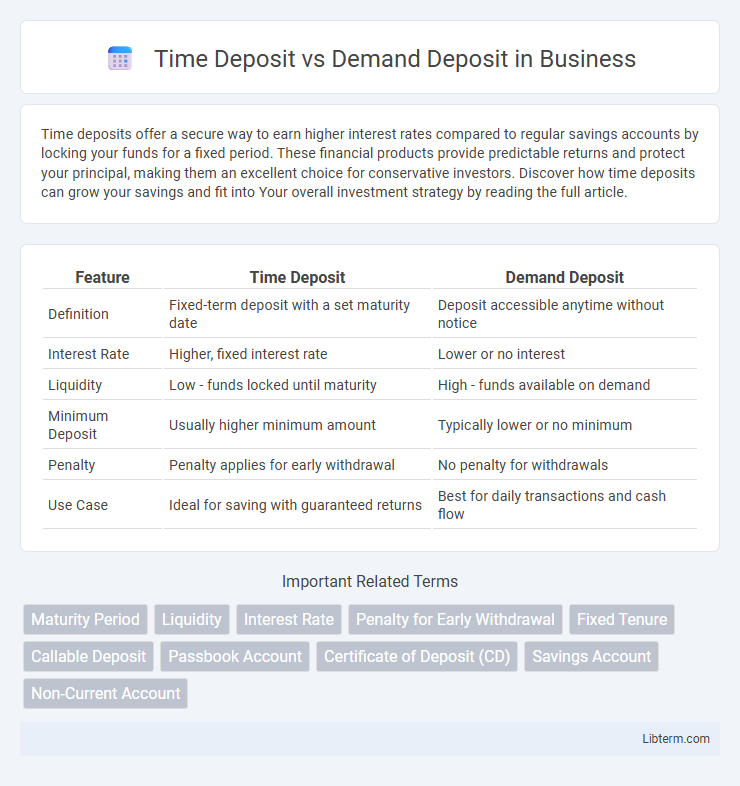Time deposits offer a secure way to earn higher interest rates compared to regular savings accounts by locking your funds for a fixed period. These financial products provide predictable returns and protect your principal, making them an excellent choice for conservative investors. Discover how time deposits can grow your savings and fit into Your overall investment strategy by reading the full article.
Table of Comparison
| Feature | Time Deposit | Demand Deposit |
|---|---|---|
| Definition | Fixed-term deposit with a set maturity date | Deposit accessible anytime without notice |
| Interest Rate | Higher, fixed interest rate | Lower or no interest |
| Liquidity | Low - funds locked until maturity | High - funds available on demand |
| Minimum Deposit | Usually higher minimum amount | Typically lower or no minimum |
| Penalty | Penalty applies for early withdrawal | No penalty for withdrawals |
| Use Case | Ideal for saving with guaranteed returns | Best for daily transactions and cash flow |
Understanding Time Deposits and Demand Deposits
Time deposits, also known as fixed deposits, require funds to be locked in for a predetermined period, offering higher interest rates compared to demand deposits, which provide immediate access to funds with lower interest returns. Demand deposits, such as checking accounts, prioritize liquidity and ease of transactions, allowing unlimited withdrawals and transfers without penalties. Understanding the trade-off between higher returns with limited access in time deposits and flexible access with lower earnings in demand deposits helps individuals optimize their savings strategy.
Key Features of Time Deposits
Time deposits, also known as fixed deposits or certificates of deposit, offer higher interest rates compared to demand deposits due to a fixed investment period ranging from one month to several years. Interest on time deposits is typically compounded periodically and paid at maturity or specified intervals, providing predictable returns without liquidity until the term ends. Early withdrawal penalties apply, reflecting the locked-in nature of funds, distinguishing time deposits from the more flexible demand deposits used for daily transactions.
Essential Characteristics of Demand Deposits
Demand deposits offer immediate access to funds without restrictions, enabling unlimited withdrawals and transfers at any time. They typically do not earn interest or provide lower interest rates compared to time deposits, reflecting their high liquidity and flexibility. Banks classify demand deposits as a key component of their liabilities, used primarily for daily transactions and cash management.
Interest Rates: Time Deposit vs Demand Deposit
Time deposits typically offer higher interest rates compared to demand deposits due to the fixed term commitment, allowing banks to use the funds more efficiently. Demand deposits provide lower or negligible interest rates because they offer liquidity and immediate access to funds without penalties. The interest rate differential reflects the trade-off between earning potential and accessibility in these deposit types.
Liquidity and Accessibility Comparison
Time deposits offer lower liquidity as funds are locked for a fixed term, usually ranging from months to years, making early withdrawals subject to penalties. Demand deposits provide high accessibility, allowing account holders to withdraw funds at any time without restrictions, ideal for daily transactions and emergencies. The trade-off between these deposit types centers on liquidity needs versus interest rate benefits.
Risk Factors: Safeguarding Your Funds
Time deposits offer higher interest rates with lower risk due to fixed terms and limited access, reducing exposure to market volatility and withdrawal risks. Demand deposits provide greater liquidity but carry higher risks of immediate withdrawals and lower interest returns, impacting long-term financial growth. Understanding these risk factors helps investors safeguard funds by balancing accessibility with potential earnings stability.
Withdrawal and Maturity Terms
Time deposits require funds to remain locked until the maturity date, with early withdrawal often incurring penalties or forfeiting interest. Demand deposits allow account holders to withdraw funds at any time without restrictions, providing maximum liquidity. The maturity term of time deposits ranges from a few months to several years, while demand deposits have no fixed maturity.
Suitability for Different Financial Goals
Time deposits suit individuals seeking predictable returns and disciplined savings over a fixed period, ideal for medium- to long-term financial goals like buying a home or funding education. Demand deposits offer high liquidity and easy access to funds, making them suitable for emergency savings or daily expenses. Choosing between time deposit and demand deposit depends on prioritizing either higher interest earnings with limited access or immediate fund availability for short-term needs.
Tax Implications for Depositors
Time deposits often have fixed terms with interest earnings subject to taxation at maturity, potentially resulting in a lump-sum tax liability based on accrued interest income. Demand deposits provide liquidity with interest typically taxed as ordinary income in the period received, allowing for more frequent tax event recognition. Understanding the timing of interest income recognition is crucial for optimizing tax strategies between time deposits and demand deposits.
Choosing the Right Deposit Option for You
Choosing between a time deposit and a demand deposit depends on your financial goals and liquidity needs. Time deposits generally offer higher interest rates in exchange for locking funds for a fixed term, making them ideal for long-term savings. Demand deposits provide easy access to funds without penalties, suitable for daily transactions and emergency cash flow.
Time Deposit Infographic

 libterm.com
libterm.com